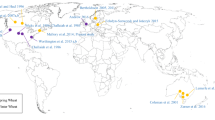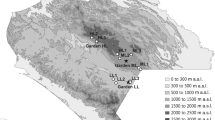Abstract
Although the effect of local adaptation is well documented in evolutionary biology, few studies have quantified the impact of local adaptation in plant breeding. Decentralized plant breeding programs have the potential to harness local adaptation for crop improvement, but the effectiveness of such models is understudied. We quantified the ability of a decentralized participatory plant breeding program to improve Weed-competitive ability (WCA) in organic spring wheat. After four farmers in the northeast United States selected wheat populations for WCA and its correlated trait of early vigor, we tracked gains in selection and local adaptation. On average, farmers enhanced competitive ability of selected genotypes by 11.46%. Measured gains from selection for early vigor and early canopy cover, however, varied among testing environments. Gains in selection were highly related to the genetic correlation coefficient between selection and testing environment (r = 0.77 and r = 0.80 for early vigor and canopy cover, respectively). To accurately measure gains from selection for decentralized breeding programs, testing environments should be chosen that are similar to where selection took place. Inconsistent weed competition among site-years limited conclusions from the analysis of local adaptation for weed competitive ability. Detecting local adaptation in plant breeding, which typically uses a small number of selection cycles compared to evolutionary biology, likely requires many genotypes, environments, and years for adequate statistical power. The ecological complexity of weed competitive ability further complicates experimental design and challenges the ability to measure local adaption.




Similar content being viewed by others
References
Annicchiarico P, Bellah F, Chiari T (2005) Defining subregions and estimating benefits for a specific-adaptation strategy by breeding programs: a case study. Crop Sci 45:1741–1749. https://doi.org/10.2135/cropsci2004.0524
Atlin GN, Frey KJ (1990) Selecting oat lines for yield in low-productivity environments. Crop Sci 30:556–561. https://doi.org/10.2135/cropsci1990.0011183X003000030017x
Bates D, Maechler M, Bolker B, Walker S (2015) Fitting linear mixed-effects models using lme4. J Stat Softw 67:1–48
Ceccarelli S (2015) Efficiency of Plant Breeding. Crop Sci 55:87–97. https://doi.org/10.2135/cropsci2014.02.0158
Ceccarelli S, Grando S, Impiglia A (1998) Choice of selection strategy in breeding barley for stress environments. Euphytica 103:307–318. https://doi.org/10.1023/A:1018647001429
Ceccarelli S, Grando S, Bailey E et al (2001) Farmer participation in barley breeding in Syria, Morocco and Tunisia. Euphytica 122:521–536. https://doi.org/10.1023/A:1017570702689
Enjalbert J, Goldringer I, Paillard S, Brabant P (1999) Molecular markers to study genetic drift and selection in wheat populations. J Exp Bot 50:283–290. https://doi.org/10.1093/jxb/50.332.283
Evans LE, Bhatt GM (1977) Influence of seed size, protein content and cultivar on early seedling vigor in wheat. Can J Plant Sci 57:929–935
Falconer DS (1981) Introduction to Quantitative Genetics, 2nd edn. Longmann Group, London
Goldringer I (2014) Co-constructiuon of a French Program for Participatory Breeding of Wheat Cultivars Adapted to Organic Cultivation and Transformation. In: Proceedings from the EGOSGN Conference. Montreal
Goldringer I, Prouin C, Rousset M et al (2006) Rapid differentiation of experimental populations of wheat for heading time in response to local climatic conditions. Ann Bot 98:805–817. https://doi.org/10.1093/aob/mcl160
Hereford J (2009) A quantitative survey of local adaptation and fitness trade-offs. Am Nat 173:579–588. https://doi.org/10.1086/597611
Joshi KD, Musa AM, Johansen C et al (2007) Highly client-oriented breeding, using local preferences and selection, produces widely adapted rice varieties. Field Crop Res 100:107–116. https://doi.org/10.1016/j.fcr.2006.05.011
Kirk AP, Vaisman I, Martens G, Entz M (2015) Field performance of farmer-selected wheat populations in Western Canada. University of Manitoba. https://www.umanitoba.ca/outreach/naturalagriculture/articles/pdf/ppb_wheat-perform_Feb2015.pdf
Kissing Kucek L (2017) Participatory breeding of wheat for organic production. Dissertation, Cornell University
Kissing Kucek L, Darby H, Mallory E, et al (2015) Participatory breeding of wheat for organic production. In: Baker BP (ed) Proceedings of the organic agriculture research symposium. LaCrosse
Leimu R, Fischer M (2008) A meta-analysis of local adaptation in plants. PLoS ONE 3:1–8. https://doi.org/10.1371/journal.pone.0004010
Lemerle D, Gill GS, Murphy CE et al (2001) Genetic improvement and agronomy for enhanced wheat competitiveness with weeds. Aust J Agric Res 52:527–548
Mallory E, Darby H, Molloy T, Cummings E (2014) Maine and vermont organic spring wheat variety trial results. University of Maine Extension. https://extension.umaine.edu/grains-oilseeds/topics/winter-spring-wheat-variety-trials/2010-2013-maine-vermont-organic-spring-wheat-variety-trial-results/
Mangione D, Senni S, Puccioni M et al (2006) The cost of participatory barley breeding. Euphytica 150:289–306. https://doi.org/10.1007/s10681-006-0226-x
Menalled F, Gross KL, Hammond M (2001) Weed aboveground and seedbank community responses to agricultural management systems. Ecol Appl 11:1586–1601. https://doi.org/10.1890/1051-0761(2001)011
Patrignani A, Ochsner TE (2015) Canopeo: A powerful new tool for measuring fractional green canopy cover. Agron J 107:2312–2320. https://doi.org/10.2134/agronj15.0150
R Core Team (2019) R: a Language and Environment for Statistical Computing Organization. Version 3.6.0. R Foundation for Statistical Computing. http://www.r-project.org/
Rebetzke GJ, Richards RA (1999) Genetic improvement of early vigour in wheat. Aust J Agric Res 50:291–301
Rhoné B, Remoué C, Galic N et al (2008) Insight into the genetic bases of climatic adaptation in experimentally evolving wheat populations. Mol Ecol 17:930–943. https://doi.org/10.1111/j.1365-294X.2007.03619.x
Rhoné B, Vitalis R, Goldringer I, Bonnin I (2010) Evolution of flowering time in experimental wheat populations: A comprehensive approach to detect genetic signatures of natural selection. Evolution (n y) 64:2110–2125. https://doi.org/10.1111/j.1558-5646.2010.00970.x
Rivière P, Goldringer I, Berthellot J-F et al (2013) Response to farmer mass selection in early generation progeny of bread wheat landrace crosses. Renew Agric Food Syst 30:1–12. https://doi.org/10.1017/S1742170513000343
Roschewitz I, Gabriel D, Tscharntke T, Thies C (2005) The effects of landscape complexity on arable weed species diversity in organic and conventional farming. J Appl Ecol 42:873–882. https://doi.org/10.1111/J.1365-2664.2005.01072.X
Ryan MR, Smith RG, Mirsky SB et al (2010) Management Filters and Species Traits: Weed Community Assembly in Long-Term Organic and Conventional Systems. Weed Sci 58:265–277. https://doi.org/10.1614/WS-D-09-00054.1
Wickham H (2016) ggplot2: Elegant Graphics for Data Analysis. Springer-Verlag, New York, NY
Worthington M, Reberg-Horton SC, Jordan D, Murphy JP (2013) A comparison of methods for evaluating the suppressive ability of winter wheat cultivars against Italian ryegrass (Lolium perenne). Weed Sci 61:491–499. https://doi.org/10.1614/WS-D-12-00167.1
Acknowledgements
We thank Adirondack Organic Grains, Essex Farm, Grange Corner Farm, Rusted Rooster Farm, and Butterworks Farm for setting research priorities, making selections, and hosting trials. We also thank Tom Molloy, David Benscher, Amy Fox, and Erica Cummings for field support and data collection.
Funding
Finding was provided by United States Department of Agriculture, Organic Research and Extension grant 2011–51300-30697; United States Department of Agriculture, Sustainable Agriculture Research and Education grants LNE12-318 and GNE15-107; Hatch Project 149–430, 149–449; and by United States Department of Agriculture, National Institute for Food and Agriculture, Agriculture and Food Research Initiative grants 2009–65300-05661 and 2011–68002-30029.
Author information
Authors and Affiliations
Corresponding author
Ethics declarations
Conflicts of interest
The authors declare that the research was conducted in the absence of any commercial or financial relationships that could be construed as a potential conflict of interest. Mention of trade names or commercial products in this publication is solely for the purpose of providing specific information and does not imply recommendation or endorsement by the U.S. Department of Agriculture. The funders had no role in the design of the study; in the collection, analyses, or interpretation of data; in the writing of the manuscript, or in the decision to publish the results.
Data availability
The datasets generated and analyzed during the current study are available from the corresponding author on reasonable request.
Consent for publication
Provided by authors.
Code availabity
From authors upon reasonable request.
Additional information
Publisher's Note
Springer Nature remains neutral with regard to jurisdictional claims in published maps and institutional affiliations.
Rights and permissions
About this article
Cite this article
Kissing Kucek, L., Dawson, J.C., Darby, H. et al. Breeding wheat for weed-competitive ability: II–measuring gains from selection and local adaptation. Euphytica 217, 203 (2021). https://doi.org/10.1007/s10681-021-02905-w
Received:
Accepted:
Published:
DOI: https://doi.org/10.1007/s10681-021-02905-w




